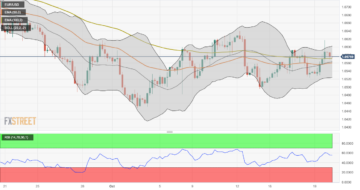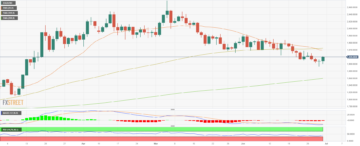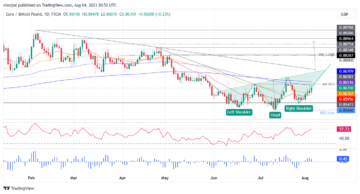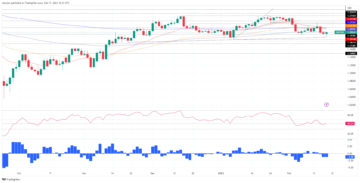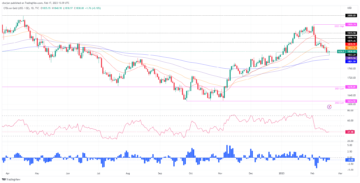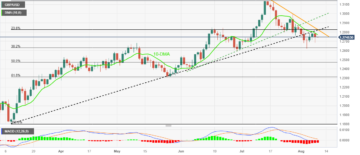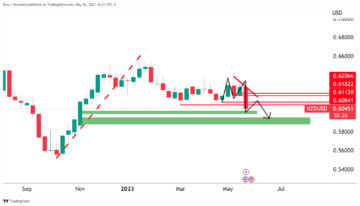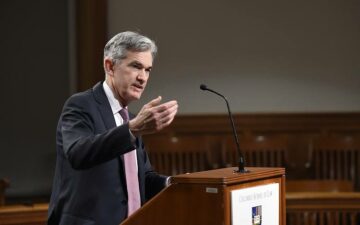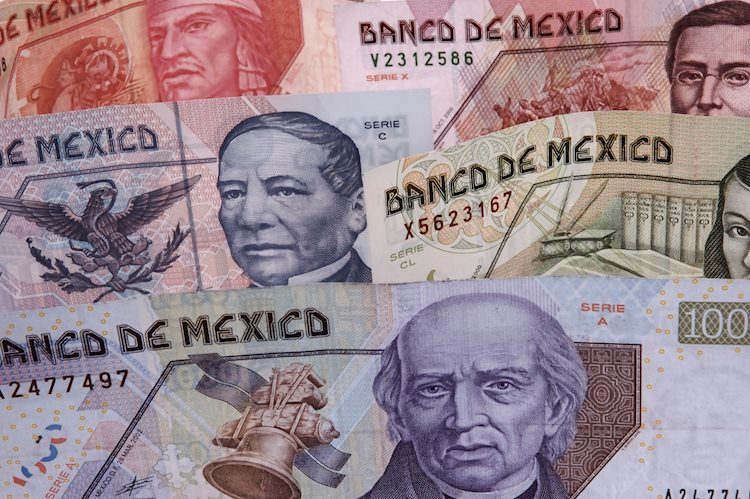
- Mexican Peso finished November with gains of more than 3.60% and began December in a positive tone.
- Mexico and US interest rate differential favors the Peso, as Fed officials have shifted dovish.
- Fed Chairman Powell acknowledges a decrease in inflation but stresses the need for more evidence to achieve the 2% target.
Mexican Peso (MXN) stages a comeback against the US Dollar (USD) as the last month of the year begins, while the Greenback posts substantial losses against a basket of six currencies, namely the US Dollar Index (DXY). The USD/MXN slips below the confluence of technical support levels, which turned resistance and trades below 17.20, down by more than 1% on the day.
The Mexican currency had a positive month in November, posting gains of 3.65%, a solid recovery compared to October’s 3.60% losses. The main driver for price action continues to be interest rate differentials between both countries, with 600 basis points of spread favoring the Mexican Peso. In addition, market participants seem confident the US Federal Reserve (Fed) ended its tightening cycle after previously “hawks” members delivered dovish remarks. In the meantime, the release of the Fed’s preferred gauge for inflation, the Core Personal Consumption Expenditures (PCE) Price Index, showed the disinflationary process in the US continued.
On the Mexican front, the Bank of Mexico (Banxico) revised its economic projections for 2023 and 2024, saying that inflation would reach its 3% target in 2025. Governor Victoria Rodriguez Ceja said discussions to ease monetary policy could begin in the first quarter of 2024. Deputy Governor Jonathan Heath emphasized the bank would be data-dependent and deliver gradual rate cuts. Ahead into the calendar, S&P Global would release the Manufacturing PMI.
Meanwhile, Federal Reserve Chairman Jerome Powell acknowledged a decrease in inflation but pointed out that core inflation remains elevated. He further stated that he requires more evidence of progress toward achieving the 2% inflation target. Powell mentioned that interest rates are acting in a restrictive manner, but he cautioned against prematurely declaring that monetary policy has become restrictive enough. He emphasized that decisions would be made on a meeting-by-meeting basis.
Daily digest movers: Mexican Peso on the offensive despite Banxico’s dovish remarks, await Fed Chair Powell
- Banxico revises economic growth upward from 3% to 3.3% for 2023 and projects the economy would rise from 2.1% to 3% in 2024.
- Regarding inflation prospects, the Mexican central bank foresees headline inflation at 4.4% in Q4 2023 (5.3% for core), while at the end of 2024, it is estimated at 3.4% (3.3% for core). The central bank forecasts headline and core inflation not to hit the 3% target imposed by the institution until 2025.
- The US Core Personal Consumption Expenditures (PCE) Price Index, the Fed’s gauge for inflation, rose by 3.5% YoY in October, as expected, below the previous month’s 3.7%.
- Headline inflation measured by the PCE Price Index slowed from 3.4% to 3.0% in the last twelve months, as foreseen by analysts.
- Interest rate traders expect 115 basis points of rate cuts by the US Federal Reserve in 2024.
- On November 27, Banxico’s Deputy Governor, Jonathan Heath, commented that core prices must come down more, adding that one or two rate cuts may come next year, but “very gradually” and “with great caution.”
- On November 24, a report revealed the economy in Mexico grew as expected in the third quarter on an annual and quarterly basis, suggesting the Bank of Mexico would likely stick to its hawkish stance, even though it opened the door for some easing.
- Mexico’s annual inflation increased from 4.31% to 4.32%, while core continued to ease from 5.33% to 5.31%, according to data on November 23.
- A Citibanamex poll suggests that 25 of 32 economists expect Banxico’s first rate cut in the first half of 2024.
- The poll shows “a great dispersion” for interest rates next year, between 8.0% and 10.25%, revealed Citibanamex.
- The same survey revealed that economists foresee headline annual inflation at 4.00% and core at 4.06%, both readings for the next year, while the USD/MXN exchange rate is seen at 19.00, up from 18.95, toward the end of 2024
Technical Analysis: Mexican Peso picks up pace as USD/MXN slips below the 20, 100-day SMAs; 17.00 in sight
The USD/MXN resumed its downtrend after briefly piercing above the 20 and 100-day Simple Moving Averages (SMAs) at 17.32 and 17.34, respectively, and reaching a two-week high shy of 17.50. Nevertheless, buyers were unable to cling to gains, and the pair has returned back below the 20 and 100-day SMAs.
For a bearish continuation, the exotic pair needs to break below 17.25, a solid resistance level during the week that turned support. Once breached, the next support would be 17.05, ahead of the psychological 17.00 figure. If bulls regain the 20-day SMA, that could open the door for USD/MXN to reclaim the 100-day SMA at 17.34, ahead of challenging 17.50.
Risk sentiment FAQs
In the world of financial jargon the two widely used terms “risk-on” and “risk off” refer to the level of risk that investors are willing to stomach during the period referenced. In a “risk-on” market, investors are optimistic about the future and more willing to buy risky assets. In a “risk-off” market investors start to ‘play it safe’ because they are worried about the future, and therefore buy less risky assets that are more certain of bringing a return, even if it is relatively modest.
Typically, during periods of “risk-on”, stock markets will rise, most commodities – except Gold – will also gain in value, since they benefit from a positive growth outlook. The currencies of nations that are heavy commodity exporters strengthen because of increased demand, and Cryptocurrencies rise. In a “risk-off” market, Bonds go up – especially major government Bonds – Gold shines, and safe-haven currencies such as the Japanese Yen, Swiss Franc and US Dollar all benefit.
The Australian Dollar (AUD), the Canadian Dollar (CAD), the New Zealand Dollar (NZD) and minor FX like the Ruble (RUB) and the South African Rand (ZAR), all tend to rise in markets that are “risk-on”. This is because the economies of these currencies are heavily reliant on commodity exports for growth, and commodities tend to rise in price during risk-on periods. This is because investors foresee greater demand for raw materials in the future due to heightened economic activity.
The major currencies that tend to rise during periods of “risk-off” are the US Dollar (USD), the Japanese Yen (JPY) and the Swiss Franc (CHF). The US Dollar, because it is the world’s reserve currency, and because in times of crisis investors buy US government debt, which is seen as safe because the largest economy in the world is unlikely to default. The Yen, from increased demand for Japanese government bonds, because a high proportion are held by domestic investors who are unlikely to dump them – even in a crisis. The Swiss Franc, because strict Swiss banking laws offer investors enhanced capital protection.
- SEO Powered Content & PR Distribution. Get Amplified Today.
- PlatoData.Network Vertical Generative Ai. Empower Yourself. Access Here.
- PlatoAiStream. Web3 Intelligence. Knowledge Amplified. Access Here.
- PlatoESG. Carbon, CleanTech, Energy, Environment, Solar, Waste Management. Access Here.
- PlatoHealth. Biotech and Clinical Trials Intelligence. Access Here.
- Source: https://www.fxstreet.com/news/mexican-peso-appreciates-against-the-us-dollar-ahead-of-powells-speech-202312011534
- :has
- :is
- :not
- ][p
- $UP
- 10
- 17
- 19
- 2%
- 2% Inflation
- 20
- 2023
- 2024
- 2025
- 23
- 24
- 25
- 27
- 32
- 33
- 46
- 50
- 8
- a
- About
- above
- According
- Achieve
- achieving
- acknowledged
- acting
- Action
- activity
- adding
- addition
- African
- After
- against
- ahead
- All
- also
- an
- analysis
- Analysts
- and
- Animate
- annual
- ARE
- AS
- Assets
- At
- AUD
- Australian
- Australian dollar
- await
- back
- Bank
- Banking
- basis
- basket
- BE
- bearish
- because
- become
- began
- begin
- below
- benefit
- between
- Bonds
- both
- Break
- briefly
- Bringing
- Bulls
- but
- buy
- buyers
- by
- CAD
- Calendar
- Canadian
- Canadian Dollar
- capital
- caution
- central
- Central Bank
- certain
- Chair
- chairman
- challenging
- chf
- come
- Comeback
- commented
- Commodities
- commodity
- compared
- confident
- confluence
- consumption
- content
- continuation
- continued
- continues
- Core
- core inflation
- could
- countries
- crisis
- cryptocurrencies
- currencies
- Currency
- Cut
- cuts
- cycle
- data
- day
- Debt
- December
- decisions
- decrease
- Default
- deliver
- delivered
- Demand
- deputy
- Despite
- Digest
- discussions
- Dollar
- Domestic
- Door
- Dovish
- down
- driver
- due
- dump
- during
- Dxy
- ease
- easing
- Economic
- Economic growth
- economies
- economists
- economy
- elevated
- emphasized
- end
- ended
- ends
- enhanced
- enough
- especially
- estimated
- Ether (ETH)
- Even
- evidence
- Except
- exchange
- Exchange rate
- Exotic
- expanded
- expect
- expected
- exports
- FAQ
- favors
- Fed
- Fed Chair
- Federal
- federal reserve
- Federal Reserve Chairman
- Figure
- financial
- First
- For
- forecasts
- foresee
- Franc
- from
- front
- further
- future
- FX
- Gain
- Gains
- gauge
- Global
- Go
- Gold
- Government
- government bonds
- Governor
- gradual
- great
- greater
- Greenback
- grew
- Growth
- had
- Half
- Have
- Hawkish
- he
- headline
- heavily
- heavy
- heightened
- Held
- High
- Hit
- HTTPS
- if
- imposed
- in
- increased
- index
- inflation
- Inflation remains elevated
- Institution
- interest
- INTEREST RATE
- Interest Rates
- into
- Investors
- IT
- ITS
- Japanese
- Japanese Yen
- jargon
- jerome
- jerome powell
- jonathan
- jpg
- JPY
- largest
- Last
- Laws
- less
- Level
- levels
- like
- likely
- losses
- made
- Main
- major
- manner
- manufacturing
- Market
- Markets
- materials
- May..
- meantime
- measured
- Members
- mentioned
- Mexico
- minor
- modest
- module
- Monetary
- Monetary Policy
- Month
- months
- more
- most
- Movers
- moving
- moving averages
- must
- namely
- Nations
- Need
- needs
- Nevertheless
- New
- New Zealand
- next
- November
- NZD
- october
- of
- off
- offensive
- offer
- officials
- on
- once
- ONE
- open
- opened
- Optimistic
- or
- out
- Outlook
- Pace
- pair
- participants
- pce
- period
- periods
- personal
- Peso
- Picks
- plato
- Plato Data Intelligence
- PlatoData
- points
- policy
- poll
- positive
- Posts
- Powell
- preferred
- previous
- previously
- price
- PRICE ACTION
- Prices
- process
- Progress
- projections
- projects
- proportion
- prospects
- protection
- psychological
- Quarter
- rand
- Rate
- Rates
- Raw
- reach
- reaching
- recovery
- refer
- regain
- relatively
- release
- remains
- report
- requires
- Reserve
- Reserve Currency
- Resistance
- Restrictive
- return
- Revealed
- Rise
- Risk
- Risky
- ROSE
- ruble
- s
- S&P
- S&P Global
- safe
- Said
- same
- saying
- seem
- seen
- sentiment
- shifted
- shines
- showed
- Shows
- Simple
- since
- SIX
- SMA
- SMAs
- solid
- some
- South
- South African
- south african rand
- spread
- stages
- stance
- start
- starts
- stated
- Stick
- stock
- Stock markets
- Strengthen
- strict
- substantial
- such
- Suggests
- support
- support levels
- Surges
- Survey
- Swiss
- Target
- Technical
- technical support
- terms
- than
- that
- The
- The Future
- The US Federal Reserve
- the world
- Them
- therefore
- These
- they
- Third
- this
- though?
- tightening
- times
- to
- TONE
- toward
- Traders
- trades
- Turned
- two
- unable
- unlikely
- until
- upward
- us
- US Dollar
- US Federal
- us federal reserve
- us government
- USD
- used
- value
- Victoria
- week
- were
- which
- while
- WHO
- widely
- will
- willing
- with
- world
- world’s
- worried
- would
- year
- Yen
- Zealand
- zephyrnet

